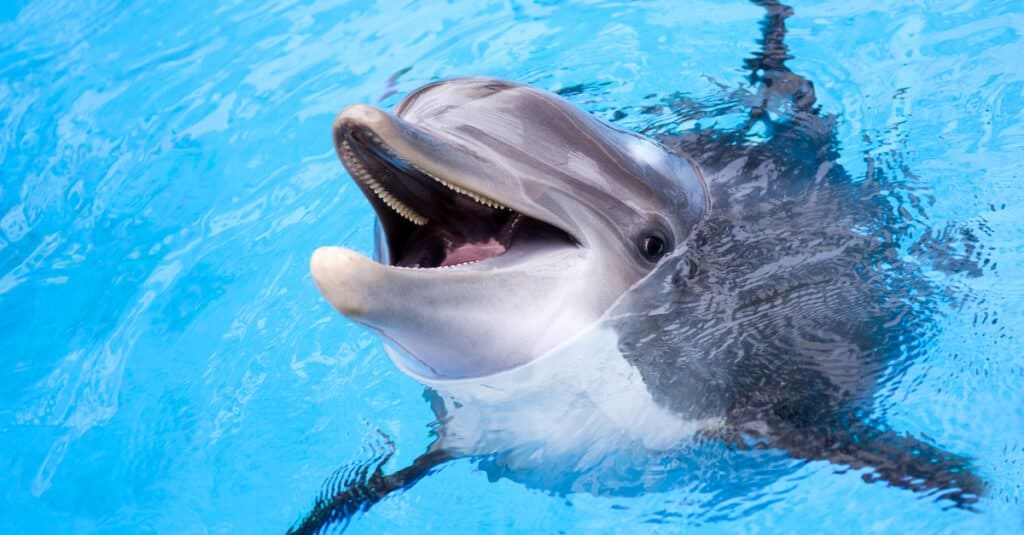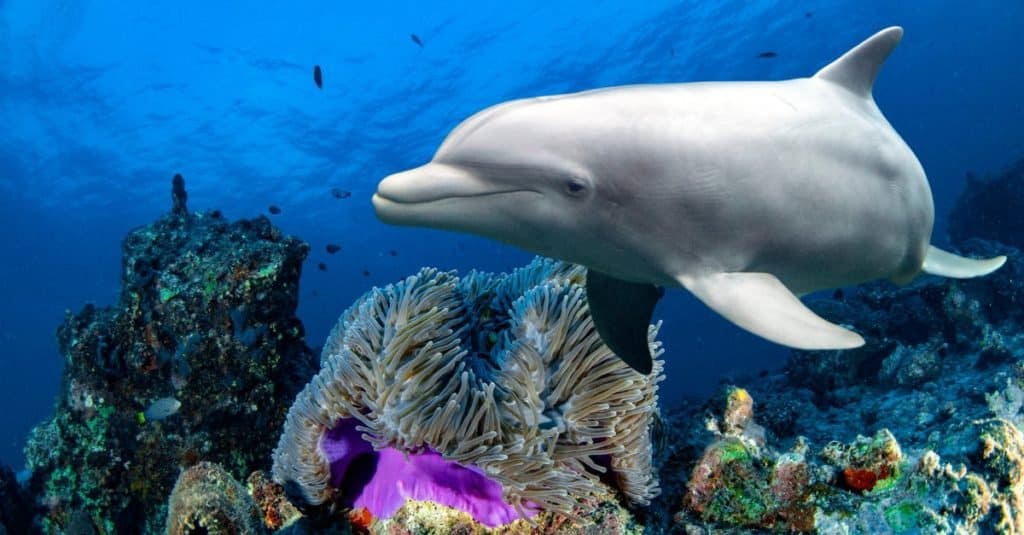Finding out you or a loved one is pregnant is one of the most exciting times in a person’s life. One of the ways that people sensationalize pregnancy is by involving the intricacies of dolphin behavior. Can dolphins really sense when you’re pregnant?
There are two kinds of dolphins in the world: ocean and river dolphins. Some examples of both types of dolphins, like the bottlenose dolphin, may be sensitive to pregnancies.
It’s well known that dolphins can sense what’s around them. Do they detect pregnancy? Can a dolphin really sense when you’re pregnant?
Can Dolphins Sense When You’re Pregnant?

Dolphins emit a beam of sound, creating an especially precise beam when presented with
human
pregnancies.
©iStock.com/Michelle de Villiers
Yes, dolphins probably sense when you’re pregnant. They’re able to do this through a special ability called echolocation.
Dolphins swim up to pregnant women and press their snouts against their bellies. They then loudly “buzz,” which is a kind of concentrated echolocation. Dolphins emit a beam of sound, creating an especially precise beam when presented with human pregnancies.
Dolphins buzz for a variety of reasons, including at other pregnant dolphins. They also do it to communicate with their birthed calves. Perhaps this is why they hone in on human pregnancies and buzz against pregnant bellies.
What Is Echolocation?
Echolocation is the process of using sounds to detect objects in space by interpreting the sounds that reflect off of those objects. These sounds are detected through auditory means and visual means. It’s believed that a dolphin’s brain produces an image of the object being detected by echolocation.
Its most frequent use is for locating prey. It’s also frequently used as a means of navigating dark environments.
Echolocation is a lot like a human ultrasound which is how we see babies in utero during pregnancy. Ultrasounds use sound waves that are too high for human ears to image the baby in space.
The ability to echolocate is most likely a learned behavior. Dolphin calves aren’t known to use echolocation though they can interpret messages from others. Mothers have been observed repeating clicks and other noises to their calves repeatedly for up to a week at a time.
Some dolphins rely so heavily on echolocation that they lost their ability to see. These dolphins almost always live in a murky environment that isn’t conducive to eyesight. The south Asian river dolphin is an example of such a species.
How Does a Dolphin Sense a Pregnancy?

It may also be possible that a dolphin can sense the heartbeat of a fetus.
©Irina No/Shutterstock.com
A dolphin’s sound waves created for echolocation may be able to detect the presence of a fetus in a body. To do this, a dolphin must be familiar with the person so it can sense a change in the person. Trainers are a good example of people who report this type of pregnancy detection.
It may also be possible that a dolphin can sense the heartbeat of a fetus. If this is the case, it’s believed they can detect pregnancies in strangers. Since dolphins can detect objects hidden in boxes, it’s not implausible.
What Other Animals Besides Dolphins Use Echolocation?
Bats, whales, aye-ayes, shrews, tenrecs, some nocturnal birds, and possibly hedgehogs are animals besides dolphins that use echolocation. Almost all animals that developed the ability to echolocate live in dark environments that render eyesight useless.
Bats are second to dolphins when it comes to their fame for being echolocators. Most use their abilities to echolocate in the dark to find insects. A few use it for navigation.
Some toothed whales, like the beluga whale, use echolocation. They do this for many of the same reasons as dolphins. The biology behind how their echolocation works is a bit different between whales and dolphins.
Small cave-dwelling birds in southeastern Asia called swiftlets live in dark caves that call for echolocation skills. These swiftlets emit up to 6 clicks per second so they can properly navigate their environment.
Do Humans Use Echolocation?
Yes, some blind humans use echolocation. They emit clicks, either vocally or artificially, which they’re able to hear reflect off of the objects around them. This helps them navigate their environment even though they can’t see anything.
How Smart Are Dolphins?

Dolphins may be capable of doing higher math.
©grafxart/Shutterstock.com
Dolphins are considered the second smartest animal on the planet. They’re second only to human beings. However, it’s important to remember that even if a dolphin can sense a fetus, the chances of it knowing that it is an unborn human baby are low.
Dolphins may be capable of doing higher math. Particularly, they may use nonlinear math during echolocation. They also experience boredom and will violently play with other animals before killing them.
The Navy and Echolocation
The Navy in the United States and various other countries sometimes use sonar that’s damaging to animals that echolocate. Sonar is most often used to detect underwater objects using sound in the same general manner as echolocation. This generic sonar is almost always not harmful to the animals in the surrounding environment.
However, these artificial sound waves have been used experimentally as a means of sending encrypted messages or as a novel weapon. These experiments were deadly to surrounding populations of dolphins and whales. Entire pods have beached themselves in response to the introduced sonar.
It’s believed that specific sonar technology confuses animals which causes them to rise to the surface too quickly. If an animal at a considerable depth in the ocean rises to the surface too fast, bubbles form in its blood, and this is almost always fatal.
Deep diving animals like beaked whales are especially vulnerable to anti-submarine warfare exercises pulsing sonar around the Mariana trench. The Navy of multiple countries believes its technology isn’t harming wildlife.
Other Proposed Health Benefits of Dolphins

It’s best to remember that dolphins are wild animals, even if they’re in captivity.
©Andrea Izzotti/Shutterstock.com
Some believe that dolphins stimulate the brains of unborn humans via echolocation. Proponents say it’s a lot like playing music for an unborn human baby. Music that is played for a fetus is recognized as early as the first trimester and may increase auditory comprehension in life.
Pseudoscientific claims say that echolocation can treat human diseases. These claims are not based on real science. It’s also claimed that dolphins can detect cancerous tumors, which isn’t substantiated.
Natural births are being performed near dolphins at an increasing rate. This is a bad idea because dolphins are powerful carnivores that already show excitement around pregnant women before blood is in the water. It’s best to remember that dolphins are wild animals, even if they’re in captivity.
The photo featured at the top of this post is © iStock.com/NaluPhoto
Thank you for reading! Have some feedback for us? Contact the AZ Animals editorial team.






